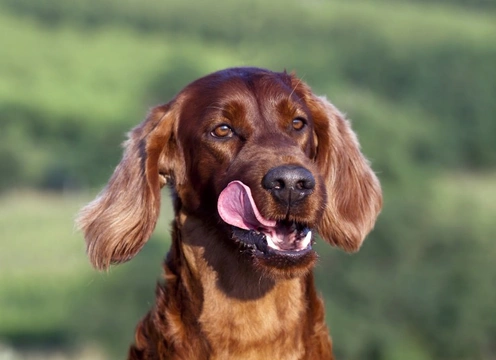
Megaoesophagus (MO) in the Irish Setter
When a dog eats, the food travels through the oesophagus to the stomach and it does so because the muscles found there contract which allows for food to be pushed along it and down to their stomachs. This function is known as peristalsis"". When a dog's oesophagus is compromised becoming flabby and larger than normal, it is a disorder that is known as megaoesphagus or MO. The result makes it extremely difficult or virtually impossible for food to pass through the oesophageal tube to a dog's stomach because the “peristaltic function” does not work as it should. Food then stays in a dog's oesophagus which they then regurgitate. It's a condition that affects many breeds including the Irish Setter.
A congenital disorder in the breed
Studies have shown that in some cases, the condition is present at birth and as such it is congenital which is the case in Irish Setters. The condition often goes unnoticed in nursing puppies and it is not until a puppy is weaned that owners and breeders notice that they are regurgitating their food. It can be food regurgitated through a puppy's mouth as well as fluid via through their noses. Puppies may also have coughing fits, make gurgling or rattling sounds and they are typically a lot smaller than their littermates. With this said, MO is also a condition that can be acquired later in a dog's life which is typically when they are around 4 years old or older. In either case the symptoms are the same and the prognosis tends to be poor.
Signs to watch out for
The most typical sign to watch out for is when a puppy starts to regurgitate their food. Other signs to watch out include the following:
- Weight loss and muscle wastage
- Weakness
- Lack of condition
- An increase in swallowing
- Excessive drooling
- Dehydration
- An increased appetite
- Stunted growth
- Coughing
- Difficulty breathing
- Pneumonia
The difference between regurgitation and vomiting
When a dog regurgitates their food, it is different to when they vomit. When dogs vomit, they bring up the contents of their stomachs which is done when the muscles in their abdomens contract. Regurgitation on the other hand, is when the food never reaches the stomach and as such a dog does not ""sick"" or retch up their food. When a puppy regurgitates food, it is typically quickly eaten up by littermates which is why the condition means often goes unnoticed by breeders or owners until puppies are weaned.
Why some Irish Setter puppies are more affected than others
Some Irish Setters are more affected by the condition than others because they don't show all the symptoms of suffering from the condition or very few of them. A lot of the time, the only real signs of there being something wrong is when a puppy continuously suffers from a wet cough or bouts of aspiration pneumonia.
Puppies can grow out of the problem when they inherit congenital MO and they can go on to live full, normal lives whereas others are more affected by the condition and need a lot more in the way of supportive care for the remainder of their lives. This involves careful food management. However, when a puppy suffers from a more severe case of MO, it is often much kinder to put them to sleep rather than let them suffer unnecessarily. It is worth noting that when MO is acquired in an older Irish Setter or other breed of dog, the prognosis tends to be very poor.
Diagnosing the condition
The way a vet would come to a definitive diagnosis would be to give a puppy suspected of having MO a normal meal. If the puppy is suffering from the condition, the food will remain in their oesophageal pouch which is located at the front of the stomach rather than move through the oesophagus and into the stomach. They would then regurgitate the food quite quickly. A vet would also want to carry out x-rays of an Irish Setter suspected of suffering from Megaoesophagus to confirm their suspicions.
Other reasons why a dog might regurgitate their food
There are other reasons why a dog or puppy may regurgitate their food with one of them also being a congenital disorder which involves what is referred to as a vascular ring abnormality known as ""persistent right aortic arch"". This is a condition that can be surgically corrected providing the procedure is carried out in a timely manner. A vet would establish whether an Irish Setter puppy is suffering from MO or if they are regurgitating their food for another reason before deciding on the best cause of action to treat them.
""



